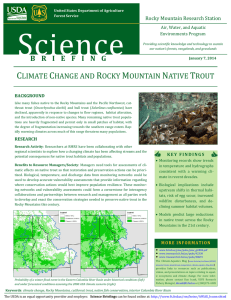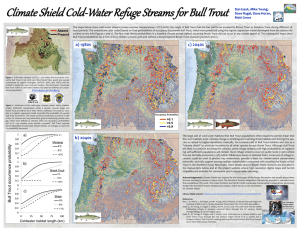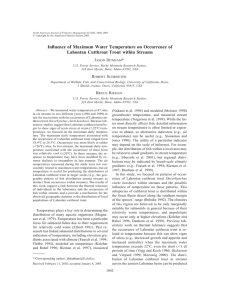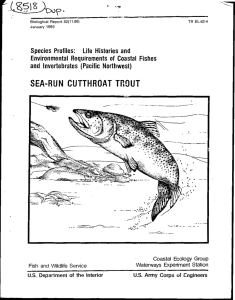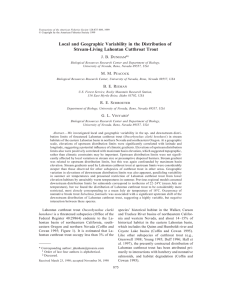Climate Shield Cold - Water Refuge Streams for Cutthroat Trout
advertisement
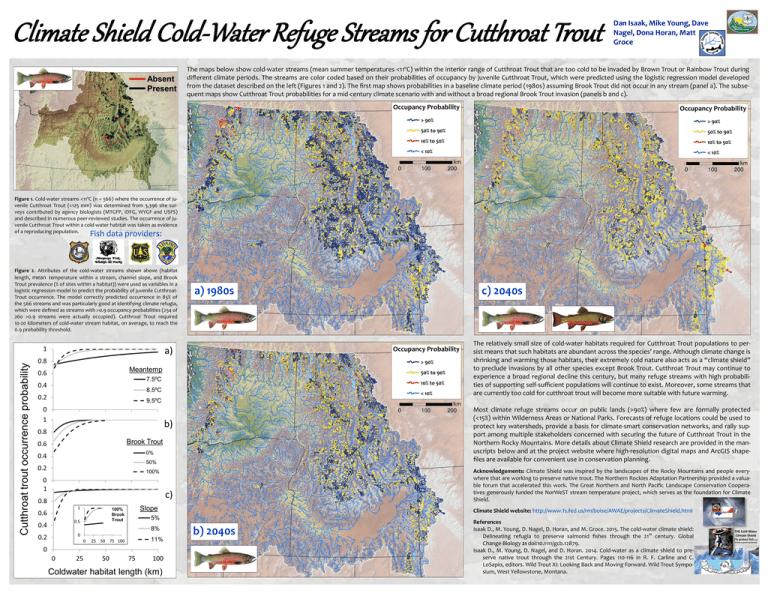
Climate Shield Cold Cold--Water Refuge Streams for Cutthroat Trout Dan Isaak, Mike Young, Dave Nagel, Dona Horan, Matt Groce The maps below show cold-water streams (mean summer temperatures <11ºC) within the interior range of Cutthroat Trout that are too cold to be invaded by Brown Trout or Rainbow Trout during different climate periods. The streams are color coded based on their probabilities of occupancy by juvenile Cutthroat Trout, which were predicted using the logistic regression model developed from the dataset described on the left (Figures 1 and 2). The first map shows probabilities in a baseline climate period (1980s) assuming Brook Trout did not occur in any stream (panel a). The subsequent maps show Cutthroat Trout probabilities for a mid-century climate scenario with and without a broad regional Brook Trout invasion (panels b and c). Figure 1. Cold-water streams <11ºC (n = 566) where the occurrence of juvenile Cutthroat Trout (<125 mm) was determined from 3,396 site surveys contributed by agency biologists (MTGFP, IDFG, WYGF and USFS) and described in numerous peer-reviewed studies. The occurrence of juvenile Cutthroat Trout within a cold-water habitat was taken as evidence of a reproducing population. Fish data providers: Figure 2. Attributes of the cold-water streams shown above (habitat length, mean temperature within a stream, channel slope, and Brook Trout prevalence (% of sites within a habitat)) were used as variables in a logistic regression model to predict the probability of juvenile CutthroatTrout occurrence. The model correctly predicted occurrence in 85% of the 566 streams and was particularly good at identifying climate refugia, which were defined as streams with >0.9 occupancy probabilities (254 of 260 >0.9 streams were actually occupied). Cutthroat Trout required 10-20 kilometers of cold-water stream habitat, on average, to reach the 0.9 probability threshold. a) 1980s c) 2040s The relatively small size of cold-water habitats required for Cutthroat Trout populations to persist means that such habitats are abundant across the species’ range. Although climate change is shrinking and warming those habitats, their extremely cold nature also acts as a “climate shield” to preclude invasions by all other species except Brook Trout. Cutthroat Trout may continue to experience a broad regional decline this century, but many refuge streams with high probabilities of supporting self-sufficient populations will continue to exist. Moreover, some streams that are currently too cold for cutthroat trout will become more suitable with future warming. Most climate refuge streams occur on public lands (>90%) where few are formally protected (<15%) within Wilderness Areas or National Parks. Forecasts of refuge locations could be used to protect key watersheds, provide a basis for climate-smart conservation networks, and rally support among multiple stakeholders concerned with securing the future of Cutthroat Trout in the Northern Rocky Mountains. More details about Climate Shield research are provided in the manuscripts below and at the project website where high-resolution digital maps and ArcGIS shapefiles are available for convenient use in conservation planning. Acknowledgements: Climate Shield was inspired by the landscapes of the Rocky Mountains and people everywhere that are working to preserve native trout. The Northern Rockies Adaptation Partnership provided a valuable forum that accelerated this work. The Great Northern and North Pacific Landscape Conservation Cooperatives generously funded the NorWeST stream temperature project, which serves as the foundation for Climate Shield. Climate Shield website: http://www.fs.fed.us/rm/boise/AWAE/projects/ClimateShield.html b) 2040s References Isaak D., M. Young, D. Nagel, D. Horan, and M. Groce. 2015. The cold-water climate shield: Delineating refugia to preserve salmonid fishes through the 21st century. Global Change Biology 21 doi:10.1111/gcb.12879. Isaak D., M. Young, D. Nagel, and D. Horan. 2014. Cold-water as a climate shield to preserve native trout through the 21st Century. Pages 110-116 in R. F. Carline and C. LoSapio, editors. Wild Trout XI: Looking Back and Moving Forward. Wild Trout Symposium, West Yellowstone, Montana.


